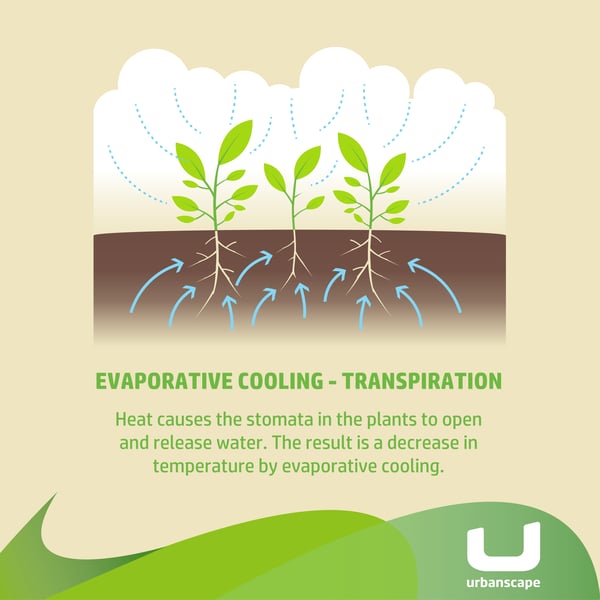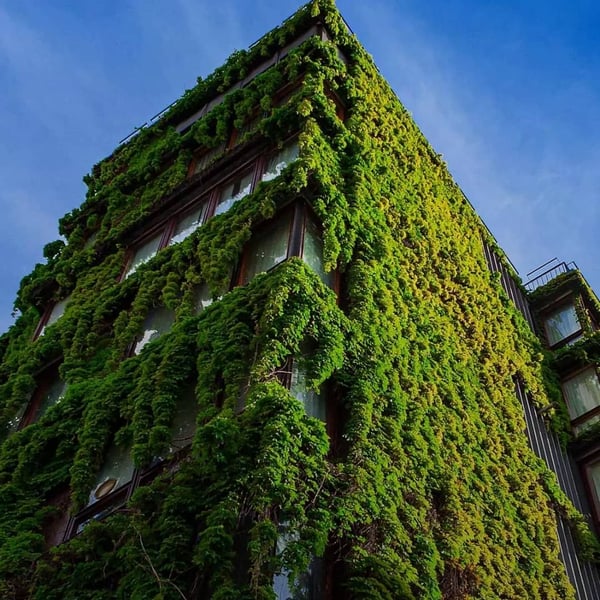Reducing energy use and air pollution are two major challenges we face in the developed world. Buildings account for 39% of the total US and 40% of the European Union’s energy consumption. Additionally, air pollution negatively affects our quality of life and health conditions. (1)
In recent years, both issues have failed to be adequately addressed by conventional construction methods and materials. This calls for alternative approaches to make use of external building surfaces to mitigate the problems we face. Apart from the roof, it is sometimes easy to forget that the facade is the most noteworthy building element that could influence a building’s energy use. (1) So what can be done to take advantage of those surfaces?
What is the green roofs and facades anyway?
To start at the beginning, they both fall in the category of green infrastructure. Green infrastructure is a set of manmade (normally vegetated) elements that provide multiple environmental functions at building and urban scale. Those include saving energy, providing ambient cooling and reducing the urban heat island effect. Green roofs and facades represent some of the most useful, innovative and interesting construction systems for this purpose. (2)
How to they work? It is a passive system that acts through four mechanisms; the shadow produced by the vegetation, the insulation provided by vegetation and substrate, the evaporative cooling through evapotranspiration, and finally the barrier effect to the wind. (2)

Fighting heat with evapotranspiration
Hard impervious surfaces like asphalt streets and concrete or brick building facades work to increase temperatures in cities and thus cause both discomfort increased cooling costs for city dwellers. Urban heat islands can affect communities by increasing summer-time peak energy demand, air pollution and greenhouse gas emissions. It has adverse effects on human health as well, causing heat-related illness and mortality, as well as a reduction in water quality. (3)
The use of vegetated roofs and facades can mitigate these problems with the help of a process called evapotranspiration – a natural process that helps reduce heat with the help of a combination of plant breathing and water evaporation. (3) Heat causes the stomata in the plants to open and release water. The result is a decrease in temperature by evaporative cooling.
In addition, vegetated roofs and green spaces contribute to vertical mixing of air due to the fact the temperature in their vicinity is normally lower than the surrounding areas. Warm air rises over the hard surfaces and is replaced by the fresh air, thus reducing the heat island effect. Research shows that humid climates in particular can achieve substantial benefits of a maximum temperature decrease of 8.4 degrees Celsius with vertical greenery systems in the urban canyon setting. (3)
Air quality improvement
Vegetated surfaces in cities help reduce the amount of dangerous smog in the air. This is achieved by the filtering quality of plants that helps decrease the amounts of particles suspended in the air, and by reducing the temperature. Because of the available space in the cities, the planting trees and shrubs is often not a viable option. Thus, vegetated facades and green roofs provide a spatially economical alternative. (3)

Will green roof and facades work in any climate?
Local climatic conditions must be taken into account when planning green solutions. Results may differ from one climate area to another. However, studies have consistently confirmed that green roofs and facades provide significant advantage in just about any climate. They have scientifically confirmed the capacity of green roofs and facades to intercept both smog and solar radiation and work to facilitate cooling, observing significant differences surface temperatures. (2)
In all climates, studied vegetated facades have a more significant effect in reducing temperatures in the urban canyon. In general, best results are obtained when combining the two, facades and roofs. Studies done with models suggest that vegetated facades can reduce the effect urban heat island around 2 degrees Celsius, improving air quality, thermal comfort and health human, with savings in electricity consumption of 5% to 10%.
Vegetation can dramatically reduce the maximum temperatures of a building by shading walls from the sun, with daily temperature fluctuation being reduced by as much as 50%. (3)
However, for best results, it is of course important to work with professionals when modelling green roofs and facades to achieve best results in specific climactic conditions.
|
Urbanscape® Green Roof System - Design and construct a perfect green roof. Urbanscape® Green Roof System concepts go beyond the meaning of contemporary architecture and give a new value to the role of buildings within urban planning. They are designed not only to bring back the natural element in the urban environment but also to provide solutions for important issues such as urban heat island effect and stormwater management. Download our Urban Smart Magazine and find out more about green roofs, benefits they bring and trending news, related to green roofs. |
Sources:
(1) Green “Breathing Facades” for Occupants’ Improved Quality of Life - Faridah Hanim Mohamed Farid*, Sabarinah Sh Ahmad, Abu Bakar Abd. Raub, Mariam Felani Shaari, Faculty of Architecture, Planning and Surveying, Universiti Teknologi MARA, 40450 Shah Alam, Selangor, Malaysia
(2) New green facades as passive systems for energy savings on Buildings - Julià Coma, Gabriel Pérez, Cristian Solé, Albert Castell, Luisa F. Cabeza; GREA Innovació Concurrent, Universitat de Lleida, Edifici CREA, Pere de Cabrera s/n, 25001, Lleida, Spain.
(3) Green Facades as a New Sustainable Approach Towards Climate Change - Dr. Samar Mohamed Sheweka a, Arch. Nourhan Magdy Mohamed b
a Lecturer, Architecture Engineering Department, the British University in Egypt, Cairo, Egypt.
b Teaching assistant, Architecture Engineering Department, the British University in Egypt, Cairo, Egypt.



